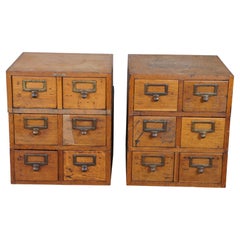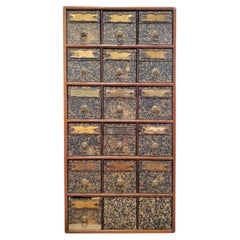Globe Wernicke Index Card Cabinet
Recent Sales
Vintage 1930s Cabinets
Oak
Early 20th Century American Arts and Crafts Apothecary Cabinets
Brass
Early 20th Century Mission Bookcases
Glass, Oak
Early 20th Century American Industrial Cabinets
Brass
Mid-20th Century American Mid-Century Modern Cabinets
Plastic, Bakelite
Finding the Right Storage-case-pieces for You
Of all the vintage storage cabinets and antique case pieces that have become popular in modern interiors over the years, dressers, credenzas and cabinets have long been home staples, perfect for routine storage or protection of personal items.
In the mid-19th century, cabinetmakers would mimic styles originating in the Louis XIV, Louis XV and Louis XVI eras for their dressers, bookshelves and other structures, and, later, simpler, streamlined wood designs allowed these “case pieces” or “case goods” — any furnishing that is unupholstered and has some semblance of a storage component — to blend into the background of any interior.
Mid-century modern furniture enthusiasts will cite the tall modular wall units crafted in teak and other sought-after woods of the era by the likes of George Nelson, Poul Cadovius and Finn Juhl. For these highly customizable furnishings, designers of the day delivered an alternative to big, heavy bookcases by considering the use of space — and, in particular, walls — in new and innovative ways. Mid-century modern credenzas, which, long and low, evolved from tables that were built as early as the 14th century in Italy, typically have no legs or very short legs and have grown in popularity as an alluring storage option over time.
Although the name immediately invokes images of clothing, dressers were initially created in Europe for a much different purpose. This furnishing was initially a flat-surfaced, low-profile side table equipped with a few drawers — a common fixture used to dress and prepare meats in English kitchens throughout the Tudor period. The drawers served as perfect utensil storage. It wasn’t until the design made its way to North America that it became enlarged and equipped with enough space to hold clothing and cosmetics. The very history of case pieces is a testament to their versatility and well-earned place in any room.
In the spirit of positioning your case goods center stage, decluttering can now be design-minded.
A contemporary case piece with open shelving and painted wood details can prove functional as a storage unit as easily as it can a room divider. Alternatively, apothecary cabinets are charming case goods similar in size to early dressers or commodes but with uniquely sized shelving and (often numerous) drawers.
Whether you’re seeking a playful sideboard that features colored glass and metal details, an antique Italian hand-carved storage cabinet or a glass-door vitrine to store and show off your collectibles, there are options for you on 1stDibs.
- 1stDibs ExpertMay 5, 2023A few companies made barrister bookcases, including the F. E. Hale Manufacturing Company, Globe Wernicke, Grand Rapids Furniture Company, Gunn Furniture Company and the John Danner Company. Barrister bookcases are bookcases with solid backs and removable shelving units that get stacked inside. Doors that open outward and slide away under the shelf enclose each unit. On 1stDibs, shop a range of barrister bookcases.
- 1stDibs ExpertNovember 26, 2024To identify a Globe-Wernicke bookcase, look for a marking. Bookcases manufactured prior to 1899 will usually have the maker's name stenciled on a slat, along with a patent number or other information. Furniture made during the 20th century and beyond is typically identifiable by a paper label. Often, the label also includes a grade, size or pattern number for the bookcase. You can find pictures of Globe-Wernicke stencils and labels and patent, grade, size and pattern number reference guides on trusted online resources to assist you with the identification process. For more help with the process, consult a certified appraiser or knowledgeable antique dealer. On 1stDibs, explore a collection of Globe-Wernicke bookcases.

